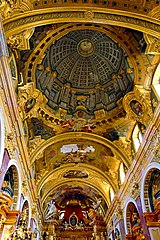|
Architectural painting Architectural painting (also Architecture painting) is a form of genre painting where the predominant focus lies on architecture, including both outdoor and interior views. While architecture was present in many of the earliest paintings and illuminations, it was mainly used as background or to provide rhythm to a painting. In the Renaissance, architecture was used to emphasize the perspective and create a sense of depth, like in Masaccio's Holy Trinity from the 1420s. In Western art, architectural painting as an independent genre developed in the 16th century in Flanders and the Netherlands, and reached its peak in 16th and 17th century Dutch painting.[1][2] Later, it developed in a tool for Romantic paintings, with e.g. views of ruins becoming very popular. Closely related genres are architectural fantasies and trompe-l'oeils, especially illusionistic ceiling painting, and cityscapes. Western artists specialized in architectural painting16th century The 16th century saw the development of architectural painting as a separate genre in Western art. The main centers in this period were Flanders and the Netherlands. The first important architectural painter was Dutch Hans Vredeman de Vries (1527–1607), who was both an architect and a painter.[3] Students of Hans Vredeman de Vries, both in Flanders and in the Netherlands, include his sons Salomon and Paul, and Hendrik van Steenwijk I. Through them the genre was popularized and their family and students turned it into one of the main domains of Dutch Golden Age painting. Flanders
Netherlands
17th centuryFlanders

Italy
NetherlandsIn the 17th century, architectural painting became one of the leading genres in the Dutch Golden Age, together with portrait painting and landscapes. Notable Dutch painter of the genre include:

18th centuryFrance
ItalyArchitectural paintings, and the related vedute or cityscapes, were especially popular in 18th century Italy. Another genre closely related to architectural painting proper were the capriccios, fantasies set in and focusing on an imaginary architecture. 
Netherlands
19th centuryAustria
Belgium
Denmark
France
Germany
Italy
United Kingdom
Modern art
Chinese architectural paintingIn China, architectural painting was called "jiehua", and mainly seen as an inferior type of painting. Known masters of the genre include the 10th century painter Guo Zhongshu, and Wang Zhenpeng, who was active around 1300.[4] Notes
Information related to Architectural painting |